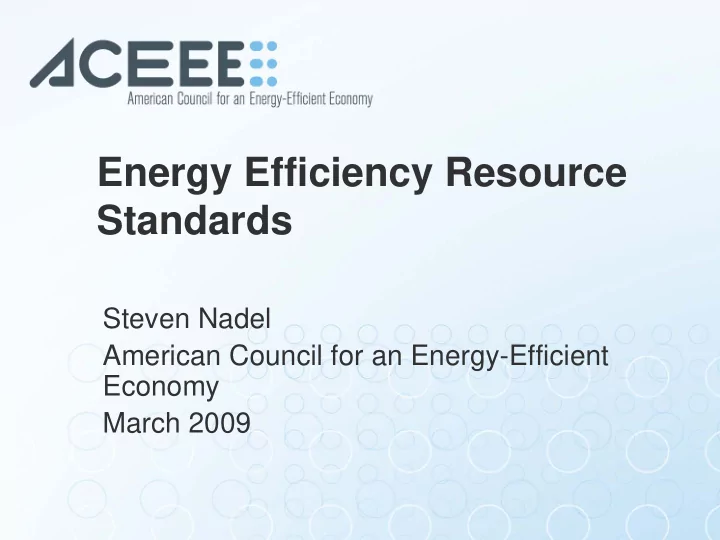

Energy Efficiency Resource Standards Steven Nadel American Council for an Energy-Efficient Economy March 2009
Share of Maryland Electricity Sales That Can Be Met by Efficiency Policies 80,000 CHP Building Codes 70,000 RD&D Initiative Appliance Standards 60,000 Electricity Demand (GWh) State and Utility Programs 50,000 29% reduction in 15% reduction in 40,000 forecasted forecasted consumption consumption by 2025 by 2015 30,000 20,000 10,000 - 2007 2009 2011 2013 2015 2017 2019 2021 2023 2025
Efficiency Programs Generate Jobs (Maryland 29% savings by 2025 scenario) 14,000 12,000 10,000 Net Job Impacts 8,000 6,000 4,000 2,000 0 2008 2010 2012 2014 2016 2018 2020 2022 2024 Source: ACEEE Feb. 2008 Maryland report
Efficiency Resources Cost Effective Evaluated results of All-Sector State-Level Energy Efficiency Programs 0.05 Levelized Cost of Saved Energy ($/kWh) 0.04 0.03 0.02 0.01 0 a t s y k t n u n i t e r a n c t o o s i e r d i m r Y t s o c e e u f r w M e J i e l h n e a V w c n N C a e o s N C s a M Source: ACEEE, “Five Years In,” 2005
Cost of New Electricity Resources 14 12 Levelized Cost (cents/kWh) 10 8 6 4 2 - Energy Wind Biomass Nat. Gas Pulverized Thin Film Nuclear Solar Coal IGCC Efficiency Combined Coal PV Thermal (a) Cycle w/o Carbon W/ $20/Ton Carbon Source: Lazard 2008 for NARUC (midpoint of range)
National Wholesale Electricity Price With an EERS (Climate Framework Scenario) Climate Framework Wholesale Electricity Prices (2006$/MWh) $85 House RES in Climate Framework 10% EE + 5% NG in Climate Framework 15-15 in Climate Framework $80 $75 $70 $65 $60 $55 $50 2020 2025 Note: Cost of efficiency programs will raise prices at retail level modestly. Source: ACEEE Dec. 2007 EERS-RES study
Midwest Wholesale Electricity Prices in Business as Usual & Efficiency Scenarios $68 Wholesale Electricity Prices (2006$/MWh) BAU $66 House RES $64 10-5 EERS 15-15 EERS $62 $60 $58 $56 $54 $52 $50 2020 2025 Source: ACEEE Dec. 2007 EERS-RES study
Energy Efficiency Resource Standards Analogous to a Renewable Portfolio Standard Electric and/or gas savings targets for utilities • Includes end-use efficiency and sometimes combined heat & power (CHP) and codes/standards • Targets generally start low and increase over time Savings must be documented in accordance with evaluation rules established by regulators Can authorize bilateral contracts to exchange savings credits and provide a role for 3 rd parties
Why an EERS? Achieve substantial energy and emissions savings Performance based – emphasizes savings, not spending Can be easier to legislate savings targets than spending amounts Can start programs quickly, without many years of study (but targets should be based on cost-effective opportunities)
States with Energy Efficiency Resource Standards (EERS) State EERS Pending EERS These plus BAU EE will save ~5% nationally by 2020
Texas • First state to establish an EERS • Initially 10% of load growth but increased by legislature to 20% of load growth • Utilities have not had difficultly meeting and exceeding targets • In 2009, bill likely to come up to increase to 30% or even 50% of load growth or the equivalent as % of sales
•Targets set in contract with Efficiency Vermont •Have exceeded each year Vermont
Vermont
What Markets Do We Work I n? Existing Efficient Homes Products Existing Businesses Equipment Replacement Business New Construction Target Sub-Markets: • Colleges and Universities • Municipal Waste and Water New Homes • K-12 Schools • Industrial Process • State Buildings Low-Income • Farms • Hospitals • Ski Areas
Markey HR 889 -- A Federal EERS • 15% electric, 10% gas savings by 2020 • Includes CHP, recycled energy, codes and standards • DOE to establish M&V protocols • Allow bilateral contracts within state; within power pool with PUC permission • 5 cents/kWh, 50 cents/therm buyout option • Funds can be used in state to operate EE programs • States implement if “willing and able” • States can set higher targets if they want
Savings Grow Over Time Electric Natural Gas Annual Cumulative Annual Cumulative 2011 0.33% 0.3% 0.25% 0.3% 2012 0.67% 1.0% 0.50% 0.8% 2013 1.00% 2.0% 0.75% 1.5% 2014 1.25% 3.3% 1.00% 2.5% 2015 1.25% 4.5% 1.00% 3.5% 2016 1.50% 6.0% 1.25% 4.8% 2017 1.50% 7.5% 1.25% 6.0% 2018 2.50% 10.0% 1.25% 7.3% 2019 2.50% 12.5% 1.25% 8.5% 2020 2.50% 15.0% 1.50% 10.0% Note: Savings count from date of passage
Other Federal Activities • Schumer (S. 548) • Virtually the same as Markey • Builds on Schumer-Landrieu 2007 amendment • Senator Bingaman draft bill • 20% RES with efficiency up to 5% EE • President Obama’s campaign platform calls for 15% electric savings by 2020, including codes and standards
How Does a Federal EERS Affect States that Already Have a State EERS? States can implement federal and state EERS simultaneously – same/similar utility filings, meet higher targets States can set higher targets to gain additional savings States with targets greater than the federal targets also benefit from savings in nearby states - Emission reductions - Impacts on energy prices
Impacts of a Federal EERS (15% electric, 10% gas by 2020; savings over and above existing state EERS’s; includes codes & standards) • Peak demand savings of 117,000 MW (390 power plants, 300 MW each) • CO2 emissions down 262 MMT in 2020 (equivalent to taking 48 million vehicles off the road for a year) • 222,000 net jobs created • Net savings of $169 billion (B/C ~3:1)
For More Information ACEEE EERS webpage: www.aceee.org/energy/national/eers.htm (Markey bill, fact sheet, PPT, state-specific analyses) Steven Nadel, snadel@aceee.org 202-507-4000
Recommend
More recommend